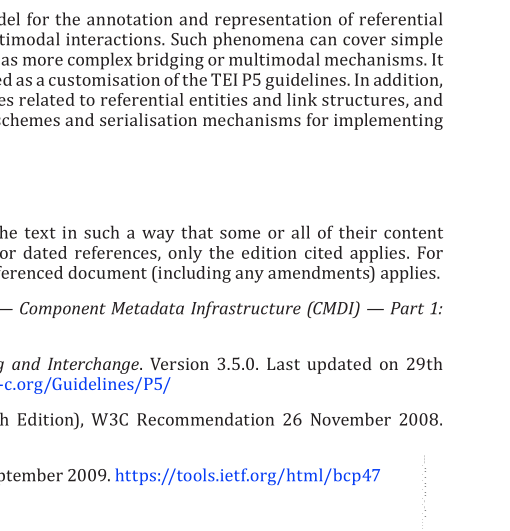ISO 24617-9:2019 pdf download – Language resource management — Semantic annotation framework — Part 9: Reference annotation framework (RAF).
where the referring expression i is a single definite description. It can also be the combination of simpler referring expressions as is the case within a coordination. EXAMPLE 2 [en] I ate [[an apple] i and [an orange] j ] k , where the referring expressions i and j are part of the larger referring expression k. It can also be expressed by one or several sub-token markers, as is the case in agglutinative languages or when referring morphemes are bound within another token. EXAMPLE 3 [it] prendo[lo] i (I take it.). Depending on the serialisation, referring expressions can be represented as explicitly recursive, by means of links among them, or implicitly recursive, by systematically pointing to their occurrences in the source text. Markables for reference annotation, however, include complex anaphors, zero pronouns, and discourse deixis. Plural pronouns such as “they” may have partial antecedents, as illustrated by Example 4 below, while zero pronouns often occur in conversations in some languages other than English, as illustrated by a Korean example below in Example 5. Discourse deixis such as “this” and “that” refer to part of what has been said in discourse. Spatial and temporal deixis such as “here”, “there”, “now”, and “then” are also to be marked up as referring expressions. EXAMPLE 4 [en] John i married Lisa j yesterday and they {i,j} went to Paris for their {i,j} honeymoon. EXAMPLE 5 Dialogue in Korean [ko]: “Mia wass-ni?” (Did Mia come?) “Yey, wass-e-yo”. (Yes, [pro] came.) NOTE The subject in the answer is implied and represented in the translation as a zero pronoun [pro]. EXAMPLE 6 [en] I don’t believe that this story of his is true. Markables are not restricted to referring expressions of nominal and pronominal forms. They may also cover verbal (anaphoric) forms such as “so do(es)” or “do”, as in the following examples. EXAMPLE 7 [en] Mary loves her husband and so does Jane. EXAMPLE 8 [en] Animals suffer as much as we do. 5.3 Data categories for referring expressions Referring expressions may be characterised by a variety of data categories that are felt to be relevant for the annotation project at hand. These categories may percolate from lower annotation levels (e.g. morpho-syntactic, syntactic or semantic) or specifically relate to the occurrence context of the referring expression. The following data categories may be considered as the basis for the characterisation of referring expressions. When the corresponding data category is not defined in another ISO standard, the definitions provided in Annex A shall be adopted. — Morpho-syntactic categories relevant for referring expressions resulting from the percolation of one or several properties of the components of the referring expression: grammatical gender (grammaticalGender, ISO 24611), grammatical number (grammaticalNumber, ISO 24611), person (person, ISO 24611). — Syntactic or semantic data categories resulting from the identification and qualification of the referring expression as a syntactic constituent: syntactic category (syntacticCategory, ISO 24615-1 1) ),
ISO 24617-9:2019 pdf download – Language resource management — Semantic annotation framework — Part 9: Reference annotation framework (RAF)






